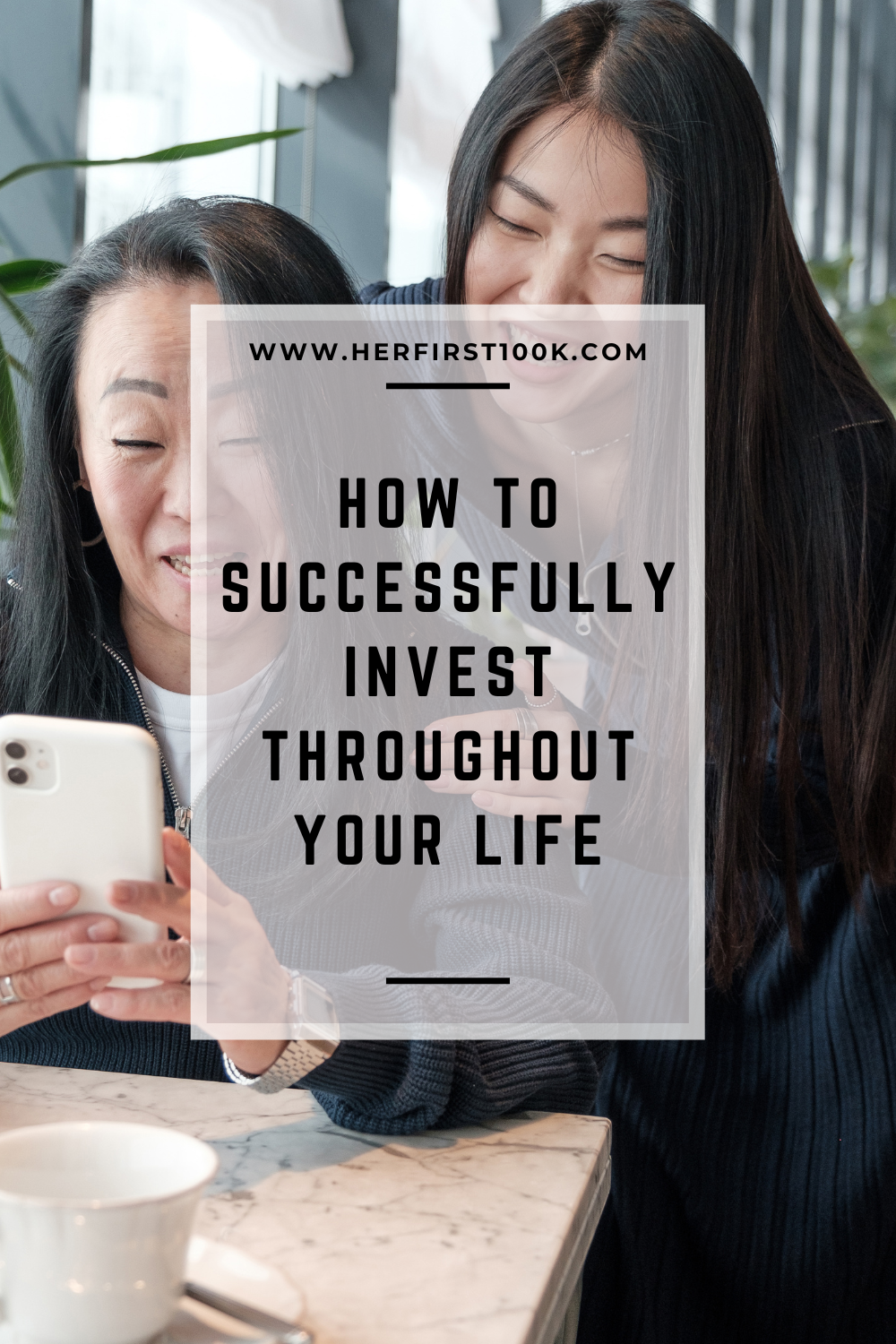The following article may contain affiliate links or sponsored content. This doesn’t cost you anything, and shopping or using our affiliate partners is a way to support our mission. I will never work with a brand or showcase a product that I don’t personally use or believe in.
How to Successfully Invest Throughout Your Life
Team, if we had a dollar for every time that we have been asked “what should my investing goals be?”…well, let’s just say that we would have enough money for our entire team to comfortably retire to a private island tomorrow.
But we completely understand why we repeatedly see this question in our comments and inbox – it’s a totally valid question that can help guide you through your investing journey so that you can navigate the stock market with confidence and intention.
And while it’s a fairly simple question, it comes with a sliiiiightly less simple answer, as your investing goals will vary from person to person and will evolve over time. But there are some general investing strategies, benchmarks, and goals we can all use and work toward throughout our life, regardless of our personal investing goals.
From when you first get started with investing to when you get to enjoy all those investments in retirement, we are helping to break down what investing goals you can work toward at every decade.
Investing goals will look different for each person
FIRST THINGS FIRST, please keep this in mind that investing goals, mindsets, and benchmarks will vary from person to person, as well as from one season of your life to another.
We don’t want you to get caught up in the belief that there is ONE perfect way, time, or strategy to invest – that kind of black and white thinking can often make us fall into the mindset of “well if I don’t invest exactly that way/didn’t get started at that time/can’t afford to invest that much money, I just won’t bother investing at all.”
Let us assure you that It is so much more important that you simply GET STARTED than waiting to start investing until you can do it “perfectly.”
After all, when it comes to investing, the most valuable asset is TIME, not money. The sooner you start investing, the more opportunity you have to take advantage of market growth and compound interest – AKA: the more opportunity you have to make money.
So even if you only have the $100 your grandma gave you for your birthday available to invest, all that matters is that you are getting started on the journey of becoming a lifelong investor.
Investing in your 20’s-30’s
Whether they are investing in the stock market or in a retirement account, many people have their first experiences with investing in their 20’s and 30’s.
When you first get started with investing, you will want to focus on building your confidence and understanding of the stock market, and setting yourself up for long-term investing success through a tax advantaged retirement account, consistent investing schedule that works for you.
Start a tax advantaged retirement account
It is never too soon to start saving for your retirement, and starting with a tax advantaged retirement account is a great way to do so. These accounts (IRA, Roth IRA, HSA, 401(k), 457 Plan) provide you a designated place to contribute funds for your retirement while also giving you certain tax advantages.
By starting to regularly contribute to a retirement account in your 20’s or 30’s, you will give yourself the most time to build wealth for retirement and reduce future financial stress.
If you are currently contributing to an employer-sponsored 401(k), make sure that you roll it over into an IRA if you switch jobs so that your retirement is protected.
Need help rolling over your 401(k)? We recommend using Capitalize – a free tool that will do all the hard work of finding your 401(k)’s and rolling them into an IRA so that you don’t have to.
Build a consistent investing schedule that is sustainable for the long-term
We have already established that the most important part of investing is “just getting started,” but “investing consistently” is a very close second.
Here’s the thing: investing is a long-term practice that allows you to grow diversified wealth over years and decades, and it is most effective when you invest consistently.
Now that doesn’t mean that you have to invest every single Tuesday at 10:00AM on the dot – the frequency and amount that you invest is totally up to you and should suit your lifestyle and your budget.
For example, Her First $100K™ founder, Tori Dunlap, likes to set aside time every two weeks to check in on her investments and contribute more to her portfolio, while Treasury co-founder, Elias Rothblatt, aims to be active in his portfolio once a month.
Finding an investing schedule that works for your lifestyle will be key in becoming a consistent and sustainable investor for decades to come. Try setting an ongoing event on your digital calendar so that you will be reminded to stay on your investing schedule and watch how this practice becomes a stable and enjoyable part of your routine.
Experiment with different investments to figure out what works best for you
When you read this next part, imagine us yelling it from the mountaintops:
You won’t know everything about investing and the stock market when you get started…and that’s totally normal and okay!
Time and experience are two key contributors to becoming a confident investor, so give yourself time to experiment with different investments to see how they perform and figure out what works best for you.
This is why we built a community element into our investing education platform, Stock Market School– we wanted new and seasoned investors alike to be able to easily discuss their investments, as well as see what others within the Stock Market School community are investing in. This allows our investors to easily discover new investments as well as gain experience in the stock market at an accelerated rate.
Create a system to check in on your investing goals each month so you can practice tracking your progress
Here at HFK, we are all about intentional investing – we never want you to get stuck into an investing strategy that is not serving you or helping you reach your financial goals. That is why we encourage you to regularly spend time in your portfolio actively tracking how your investments are performing.
We make this easy by tracking your performance for you right in the app, but you can also do a DIY version in a spreadsheet. Every three months or so, simply write down how much you have contributed to your various investments, what their current value is, and the rate at which they have increased or decreased in value.
While we don’t recommend reactionary buying and selling of investments, over time you will begin to notice trends in certain investments that can help you make educated decisions on whether you want to continue investing in those options or if you would like to redirect your money elsewhere. The confidence and understanding to do so will take some time and experience, but proactively tracking your performance will give you the resources and information to make those informed decisions.
Investing in your 30’s – 50’s
For many people, this is a season of life in which you move into a more established career with more flexibility in income. As such, this season of life is a great opportunity to maximize your investing strategy, increase your contributions, and diversify your portfolio.
Increase the percentage that you contribute to your investments
Hopefully within your 30’s – 50’s you find that you have advanced in your career, have reached some early financial goals (such as starting an emergency fund, starting a retirement account, settled into a saving routine, and have paid off some high interest debt), and have more flexibility in your disposable income.
If this is the case, this is the season you should consider increasing the amount that you contribute regularly to your investments.
The amount that each person can contribute regularly to their investments will vary based on personal circumstances, income, and the economy, but as a general rule of thumb we like to recommend that you get to a point where you invest between 6-15% of your pre-tax income.
If the amount that you contribute does not currently fall within that percentage, try increasing your contributions by 1% every few months and see how it feels. Chances are, you will not even notice the additional income that you are directing to your investments, but the additional contributions will have a significant impact on the value of your portfolio. Continue this process every few months until you comfortably fall within that 6-15% range and then focus on maintaining that investing momentum.
Want to invest more than that 15%? Go for it! Just make sure that you are still able to afford all your necessities, saving for retirement, paying off debt, and making progress towards your financial goals!
Diversify your investments
Once you have settled into a routine of consistently contributing to dependable investments that serve you well, you can focus on diversifying your portfolio with additional investments.
You may want to look into investing in certain savings plans that are specific to your personal financial goals. For example, if you want to proactively save for your children’s college education, you may want to start contributing to a 529 Plan – a tax-advantaged savings plan specifically designed for higher education. Or if you anticipate having to spend a significant amount on childcare or for the care of an adult family member, you may want to contribute to a Dependent Care FSA – a tax advantaged savings plan designed to provide funds for daycare, summer camp, preschool, nannying, and convalescent or hospice care.
Additionally, this is usually a good time to experiment with slightly more “risky” investments as they offer a higher return on investment, and you will have plenty of time to ride the highs and lows of the market in order to secure their greatest return with as little risk as possible.
Adjust your investment plan accordingly
By this point in your investment journey, you will have had plenty of time to practice tracking progress and identifying trends in your investment portfolio, so you can feel more confident taking proactive action in your investing strategy.
As you continue to track your progress over time and gain experience in the market, you can begin to strategically buy and sell investments based on your personal market performance.
Investing in your 50’s – retirement
This season of life is often when you are most established in your career, have the most disposable income, and have the most opportunity to maximize your investments. Using these last working years before retirement to make additional contributions to your investments in order to prepare for retirement will be key to securing financial security for your golden years.
Maintain momentum
By this point, you have settled into a well-established routine of investing, found dependable investments that help you reach your financial goals, and have diversified your portfolio with a range of investment types. All in all, you are well on your way to a vibrant and financially secure retirement.
But we don’t want you to slow down just yet – rather, you can strategically use these years leading up to a well-deserved retirement to increase your contributions to your investments. Think of investing like a marathon: you are now in the final leg of the race, so you are going to pick up speed for a strong finish.
Make sure that you are maxing out your contributions to your tax-advantaged savings accounts, and increase the percentage of income that you contribute to your investments in the stock market. Avoid high-risk investments and opt to invest in the stocks, funds, and bonds that have consistently performed well for you over the past several decades.
Investing in retirement
When you retire, your whole life will change, including the way that you invest. Whereas previously you were focusing on strategically investing in order to secure your financial future, you can now focus on maintaining your wealth through investing and enjoying the financial fruits of your labor – after all, you deserve it!
Focus on maintenance
Even if you are no longer in the workforce, you can continue to invest in the stock market in order to maintain your wealth. Continue to contribute to the dependable investments that have served you well in the past and avoid investing in high-risk investments, as security should be your utmost financial priority.
Strategically sell your investments as needed
Whereas you had previously been focused on holding onto your investments as long as possible, this is the season of your life in which you can start to strategically sell your high-performing stocks, bonds, and funds in order to liquidate some of your assets. It is important to do this strategically so that your investments last you as long as possible, so make sure to sell according to your financial need and your knowledge of your portfolio performance.
Consider giving to charity
You may also consider making donations to charitable organizations during this season, as these donations often have tax advantages that can be particularly beneficial in retirement.
Create investment plans for after you have passed
Finally, an important part of planning for your financial future is also planning for the future after you have passed. In this season of your life, you need to make sure that you have legal documents in order to ensure that your wishes for your investments and possessions are protected.
Take a comprehensive assessment of your investments and any additional assets you may have (property, jewelry, cars, etc.) and work with a lawyer or estate planner to designate where or to whom these assets will be given to in the event of your passing.







